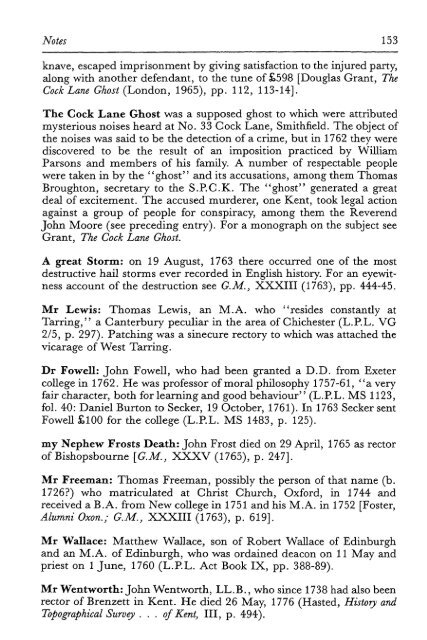Archbishop of Canterbury - KU ScholarWorks - The University of ...
Archbishop of Canterbury - KU ScholarWorks - The University of ...
Archbishop of Canterbury - KU ScholarWorks - The University of ...
Create successful ePaper yourself
Turn your PDF publications into a flip-book with our unique Google optimized e-Paper software.
Notes 153<br />
knave, escaped imprisonment by giving satisfaction to the injured party,<br />
along with another defendant, to the tune <strong>of</strong> £598 [Douglas Grant, <strong>The</strong><br />
Cock Lane Ghost (London, 1965), pp. 112, 113-14].<br />
<strong>The</strong> Cock Lane Ghost was a supposed ghost to which were attributed<br />
mysterious noises heard at No. 33 Cock Lane, Smithfield. <strong>The</strong> object <strong>of</strong><br />
the noises was said to be the detection <strong>of</strong> a crime, but in 1762 they were<br />
discovered to be the result <strong>of</strong> an imposition practiced by William<br />
Parsons and members <strong>of</strong> his family. A number <strong>of</strong> respectable people<br />
were taken in by the "ghost" and its accusations, among them Thomas<br />
Broughton, secretary to the S.P.C.K. <strong>The</strong> "ghost" generated a great<br />
deal <strong>of</strong> excitement. <strong>The</strong> accused murderer, one Kent, took legal action<br />
against a group <strong>of</strong> people for conspiracy, among them the Reverend<br />
John Moore (see preceding entry). For a monograph on the subject see<br />
Grant, <strong>The</strong> Cock Lane Ghost.<br />
A great Storm: on 19 August, 1763 there occurred one <strong>of</strong> the most<br />
destructive hail storms ever recorded in English history. For an eyewitness<br />
account <strong>of</strong> the destruction see G.M., XXXIII (1763), pp. 444-45.<br />
Mr Lewis: Thomas Lewis, an M.A. who "resides constantly at<br />
Tarring," a <strong>Canterbury</strong> peculiar in the area <strong>of</strong> Chichester (L.P.L. VG<br />
2/5, p. 297). Patching was a sinecure rectory to which was attached the<br />
vicarage <strong>of</strong> West Tarring.<br />
Dr Fowell: John Fowell, who had been granted a D.D. from Exeter<br />
college in 1762. He was pr<strong>of</strong>essor <strong>of</strong> moral philosophy 1757-61, "a very<br />
fair character, both for learning and good behaviour" (L.P.L. MS 1123,<br />
fol. 40: Daniel Burton to Seeker, 19 October, 1761). In 1763 Seeker sent<br />
Fowell £100 for the college (L.P.L. MS 1483, p. 125).<br />
my Nephew Frosts Death: John Frost died on 29 April, 1765 as rector<br />
<strong>of</strong> Bishopsbourne [GM., XXXV (1765), p. 247].<br />
Mr Freeman: Thomas Freeman, possibly the person <strong>of</strong> that name (b.<br />
1726?) who matriculated at Christ Church, Oxford, in 1744 and<br />
received a B.A. from New college in 1751 and his M.A. in 1752 [Foster,<br />
Alumni Oxon.; G.M., XXXIII (1763), p. 619].<br />
Mr Wallace: Matthew Wallace, son <strong>of</strong> Robert Wallace <strong>of</strong> Edinburgh<br />
and an M.A. <strong>of</strong> Edinburgh, who was ordained deacon on 11 May and<br />
priest on 1 June, 1760 (L.P.L. Act Book IX, pp. 388-89).<br />
Mr Wentworth: John Wentworth, LL.B., who since 1738 had also been<br />
rector <strong>of</strong> Brenzett in Kent. He died 26 May, 1776 (Hasted, History and<br />
Topographical Survey . . . <strong>of</strong> Kent, III, p. 494).

















